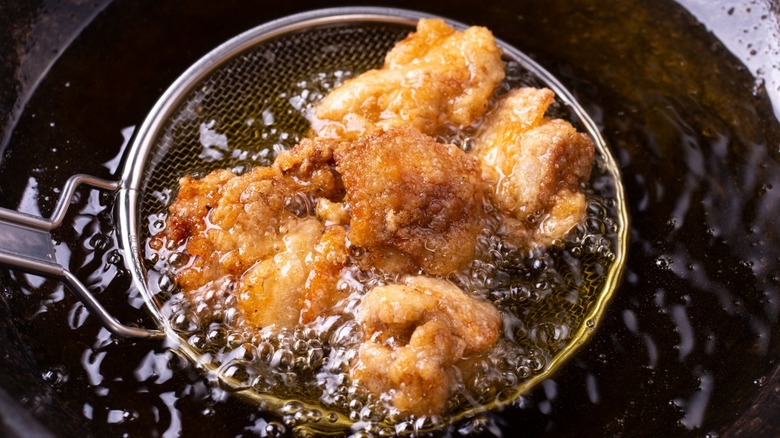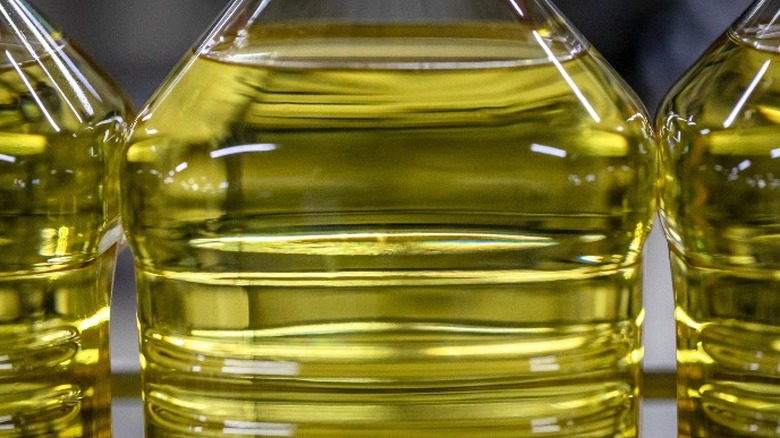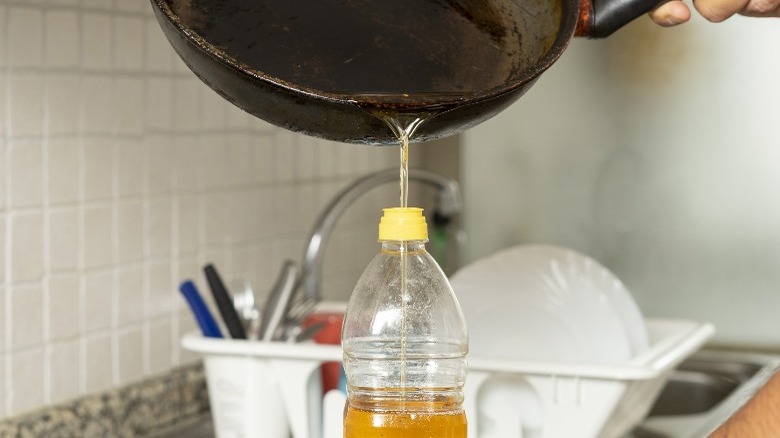The Best Ways To Use Leftover Frying Oil
We may receive a commission on purchases made from links.
Working with hot oil can be intimidating for even the most seasoned cooks. Frying can feel dangerous, and it requires practice and precision to determine if your food is cooked properly. According to Serious Eats, deep frying will dehydrate whatever food you're working with, leading it to take on that desired crunch and caramelized flavor. If deep frying feels a bit daunting, a few steps to successful deep frying will help demystify the process.
First, it's important to select the right frying oil, which is one with a high smoke point. This means you should choose an oil that can be heated to a high temperature before it starts to smoke, such as peanut or sunflower. Also, if you're not working with a deep fryer, using a deep pot is necessary to prevent splashing oil on yourself. Experts suggest filling the pot only two-thirds of the way with oil and making sure no excess moisture gets in the mix, per BBC Good Food.
Once you've covered your safety basics, it's key to shift your attention to the temperature. A deep fryer will likely have a thermometer, but if you're not using this piece of equipment, you'll still want to accurately gauge the heat of your oil. This helps avoid a soggy result and keeps your oil from smoking. Follow these steps, and when you finish frying, you'll be left with a deliciously crispy final product — as well as a vat full of oil that you fortunately won't have to throw away.
Filter your frying oil, and you can reuse it multiple times
Deep frying can seem like a wasteful cooking process because of all the oil that is leftover at the end. Luckily, you don't have to toss it out immediately. According to Cook's Illustrated, frying oil can be reused a number of times before it needs to be discarded, as long as it wasn't used to cook fish. You can use oil from breaded or battered fried foods at least two or three more times. If you've fried something with a non-flaky coating — french fries, for example — you can reuse that oil closer to six times. Before you recycle your cooled frying oil, run it through a strainer with an additional barrier placed over it, like coffee filters or cheesecloth, to remove any small particles. Cook's Illustrated advises storing it somewhere cool and dark — or even the freezer to keep it fresh for longer.
Ultimately, there's no exact science to how many times you can use leftover frying oil. However, you can easily determine if your oil has gone rancid or is past its prime. First, examine its appearance; if it's murky and the color has darkened, you probably need new oil for the job. An unpleasant odor is another telltale sign of expired oil. Finally, if you notice that your oil doesn't reach frying-level temperatures before it starts to smoke, it's time to discard it.
How to make your frying oil last longer
If you want to get the most out of your deep frying oil, reusing it is obviously a great way to make it go further. But besides simply filtering the oil, you can take a few steps to ensure that you get the most bang for your buck.
Serious Eats explains that deep fryers work better than any pot or pan you have at home. The debris that falls from the food sinks below the heaters, settling in the cooler area. However, when you're working with a regular pot, any particles that your fried food sheds will descend to the bottom and stay there — where they will burn. Certain types of dredges will leave more particles behind and dirty up your oil. For example, flour-dredged items will make the biggest mess, so you may want to save those things for the last round or two of a batch of frying oil.
If you just have to make your messiest fried chicken recipe in your fresh oil, you still can. Just be sure to pay close attention to whatever breading falls into the oil, Restaurant Business recommended. Use a spider to quickly retrieve any stray bits of breading. Plus, if you monitor the temperature of your oil, keeping it around 350 degrees rather than too hot, you'll slow its spoilage.


